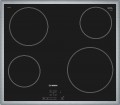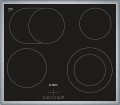Dual-circuit burner
The presence on the hob of one or more
dual-circuit burners — heaters with the possibility of increasing the diameter.
Only Hi-Light or induction hotplates can be dual-circuit burners (see "burner type"). Such a heater looks like several circles of different diameters with a common centre; each circle corresponds to one of the options of the working diameter that can be selected for the burner. The number of these options is usually 2 or 3, and if there is more than one dual-circuit burner, they may differ in the number of diameters available.
Anyway, this feature allows you to select the working size of the burner for the diameter of the dishes. This function should not be confused with the oval dual zone (see below): the oval dual zone gives the burner an elongated shape, and the dual-circuit burner remains round regardless of the selected size.
Oval dual zone
The presence of an
oval-shaped heating zone on the hob. Such a heater is useful for working with appropriate elongated dishes (for example, goose roasters). In models with electric heaters (see "Burner type") the desired shape is provided by an additional segment installed close to the burner; the burner in normal mode works like a regular round one, and when the segment is connected, it turns into an oval. In gas models, a separate elongated burner is installed.
A similar effect can be achieved using the bridge mode (see "Features"). However, the bridge and the oval zone are still different functions: the first involves combining two burners, and the second is implemented strictly on one burner.
Burners power
Nominal burners power. It refers to the power consumption of the heater. This parameter allows you to estimate how much electricity the burners will spend when operating at maximum heating intensity. At the same time, the heat transfer power of different burners can be different, and the actual heating efficiency will also greatly depend on the specs of the dishes. As a result, it hardly makes sense to evaluate the working capabilities of the hob by the power of the burners. It is quite possible to proceed from the fact that the burner will be enough for a pot of the same diameter.
Burner diameter
The heating power directly depends on the diameter of the burners. And, at the same time, the performance of the device and the speed of cooking. The larger the burner, the more heat dissipation it has. Also, the diameter of the burner allows you to determine what sizes of dishes are suitable for use on the hob. Indeed, for induction models, this value is critical for high-quality heating. Burners can have the following diameter:
- small — about 145 mm, power within 1200 W;
- medium — about 180 mm, power within 1700 W;
- large — about 220 mm and more, power within 2000 watts.
Some hobs use double ring burners that allow you to adjust the diameter of the heating zone. If the diameter of the burner is 180, 200, 220 mm, then it means that the heating zone on a particular burner can be narrowed or expanded, depending on the size of the dishes used.
Controls
The type of control used in the hob. The options might be:
—
Rotary knobs. Control based on classic rotary knobs. Sometimes buttons are also provided in the design but they are only responsible for the additional functions of the device. It is the knobs that control the switching on and power of the burners (and the combination of knobs and youch controls is indicated separately — see below). This type of control is known for its simplicity, convenience, reliability and low cost, which make it extremely popular — it is used in most modern hobs of an independent type (see above).
—
Touch controls. touch controls can control almost all functions of the hob, while the set of such functions can be very extensive. Among the advantages of touch sensors, one can note a stylish appearance, ease of cleaning due to the absence of protruding parts, and the touch controls do not need to be pressed — a light touch is enough. The main disadvantage of this type of control is its high cost, but it is mainly used in high-end hobs, where the price of touch controls is almost invisible compared to the cost of the entire device.
— Rotary knobs + touch controls. Combination of rotary knobs (see above) with touch controls. Note that only rotary knobs are enough for basic control of the burners, and buttons can also be used for additional functions — they are cheaper than touch controls. Therefore, t
...his type of control usually means that we have a rather expensive model with an abundance of additional functions. Among the advantages of touch controls, one can note a neat and stylish appearance, as well as ease of cleaning — they, unlike buttons, do not have slots and protruding parts where dirt can accumulate. And some models with similar controls have a rather unusual design — for example, only one rotary knob, the purpose of which is changed by commands from the touch controls.
— Touch + magnetic disk. Touch controls (see above), supplemented by a special rotary control — a magnetic disk. This disc is somewhat similar to rotary knobs, but it is called magnetic because of the fastening — with a permanent magnet, which allows you to remove the control. Most often, there is one disc for all burners; less often there are models with their disc for each burner. However, such a regulator has two key differences from rotary knobs. Firstly, the magnetic disk controls not only the power but most of the other functions of the hob. Secondly, the discs look neater and are more comfortable to use: they spin easily, and the detachable design makes them easy to clean and keeps children out of the way. However, it makes sense to use this control method mainly in high-end hobs with an abundance of functions.
— On the oven. As the name implies, such hobs do not have their control — it is carried out from the oven control panel to which the device is connected. This variant, by definition, only occurs in dependent models (see "Type").
— Slider. A kind of touch controls. Often they are elongated in a slender line; less often they are made in the shape of a circle. To adjust the heating intensity of the burners or quickly access other settings of the hob, slide your finger along the corresponding touch scale to the selected value. The convenience of slider control is that you can immediately set the required heating power by clicking on a certain area of the scale.
— Separate. Control using sensors or sliders (see the corresponding paragraphs), which implies the ability to fine-tune the operation of the burners individually - each of them has its own power adjustment scale. Separate control allows you to set the required heating level for a specific zone without having to first select a specific burner by tapping on the panel. It is more intuitive and gives you more flexibility when preparing different dishes overnight.Input power
The input power of the hob is the maximum electric power consumed during its operation. This parameter is indicated only for models that are equipped with at least one electric hotplate. It is electric burners that are the highest consumption in terms of energy consumption. Additional functions such as auto-ignition require little energy, and a regular outlet is enough for them.
First of all, the requirements for the power mains depend on this parameter: it must be able to provide such power without overloads. It is worth noting that for household sockets the power limit is about 3 – 3.5 kW, with more power, you need to connect the hob to 230 V mains according to special rules. An alternative is to use a three-phase 400 V mains: most modern hobs with electric burners allow connection to both 230 V and 400 V mains.
Country of origin
The country in which, according to the manufacturer, this or that model is manufactured. Despite the fact that most of the manufacturers are concentrated
in China, European factories for the production of household appliances have not disappeared. And certain models can be produced on them. In general, such a division into a Chinese or European plant should not particularly affect the quality of products, but still the stereotype of a reliable European assembly (
Germany,
Spain,
Italy,
Poland,
Turkey) is present in us. However, it is possible that the model may have a country of manufacture, for example, Poland, and in the store under the same article you will meet China.

